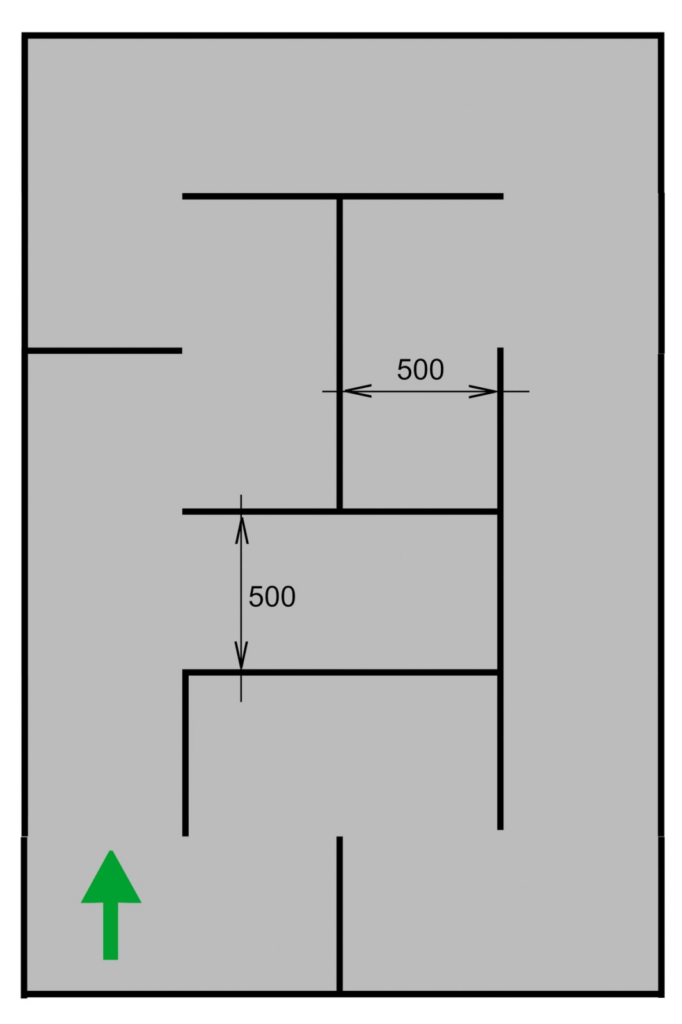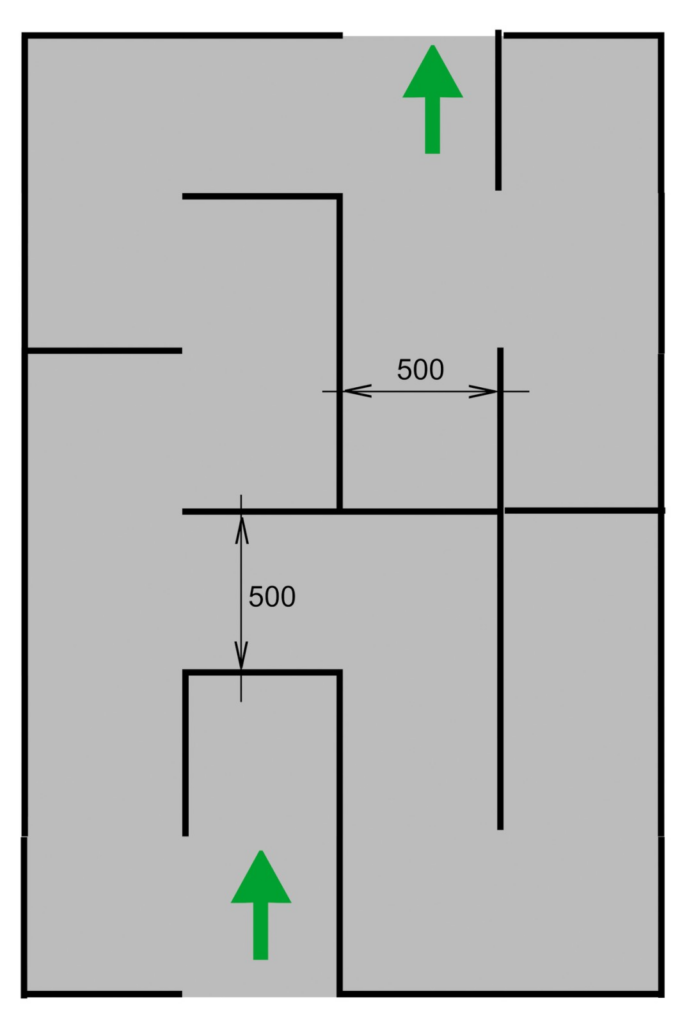Maze Solver category
Introduction
A Maze Solver is a small small robot controlled vehicle that is able to navigate its way through an unknown and unconnected maze.
The competition task
The objective for the contestant is to impart to robot an adaptive intelligence to explore different maze configurations and to work out the optimum route for the shortest travel time from start to finish.
Maze
The maze shall comprise 16 x 16 multiples of an 18 cm x 18 cm unit square. The walls constituting the maze shall be 5 cm high and 1.2 cm thick. Passageways between the walls shall be 16.8 cm wide. Based on the dimensions of the NITRObot, when you design your own maze layout, you should follow a simple rule – the minimum width of the corridor should be 500 mm (50 cm).
The side of the maze walls shall be white, and the top of the walls shall be red. The floor of the maze shall be made of wood and finished with a non-gloss black paint. The coating on the top and side of the wall shall be selected to reflect infra-red light and the coating on the floor shall absorb it.
The start of the maze shall be located at one of the four corners. At the centre of the maze shall be a large opening which is composed of 4 unit squares. This central square shall be destination.
Square posts, each 1.2cm x 1.2cm x 5cm high, at the four corners of each unit square are called lattice points. The maze shall be constituted such that there is at least one wall touching each lattice point, except for the destination square.
The dimensions of the maze shall be accurate to within 5% or 2cm, whichever is less. Assembly joints on the maze floor shall not involve steps of greater than 0.5mm. The change of slope at an assembly joint shall not be greater than 4 degrees. Gaps between the walls of adjacent squares shall not be greater than 2 mm.


Robot
Robot must be completely self-contained and must receive no outside assistance.
The method of propulsion is at the discretion of the builder, provided that the power source is non-polluting – internal combustion engines would probably be disqualified on this count.
Although the superstructure of the mice may ‘bulge’ above the top of the maze walls, mice must be subject to the following size constraints – width 25 cm, length 25 cm. There is no height limit.
The method of wall sensing is at the discretion of the builder; however, the robot must not exert a force on any wall likely to cause damage.
If the judges consider that a robot has a high risk of damaging or sullying the maze they will not permit it to run. Nothing may be deposited in the maze. The robot must negotiate the maze; it must not jump over, climb, scratch, damage or destroy the walls of the maze. No bulldozers, please.
Competition Rules
The time taken to travel from the start square to the destination square is called the ‘run’ time. Travelling from the destination square back to the start square is not considered a run. The total time taken from the first activation of the robot until the start of each run is also measured and it is limited to 5 minutes. If the robot requires any manual assistance at any time during the contest, it is considered ‘touched’ and its ‘run’ time is penalized with 3 seconds. Scoring is based on these parameters.
Each robot is allowed a maximum of 5 minutes to perform. The judges have the discretion to request a robot to retire early if by its lack of progress it has become boring, or if by erratic behaviour it is endangering the state of the maze.
The scoring of a robot shall be obtained by computing a time score for each run as follows:
Handicapped Time Score = Run Time + Touch Penalty where, Touch Penalty = 3 seconds, if the robot has been touched at any time prior to the run.
Fastest time score counts for a robot.
When the robot reaches the destination square, it may stop and remain at the maze centre, or it may continue to explore other parts of the maze, or make its own way back to the start. If the robot chooses to stop at the centre, it may be lifted out, manually, and restarted by the handler. Manually lifting it out shall be considered touching the robot and will cause a touch penalty to be added on all subsequent runs. If the robot does not choose to remain in the destination square, it may not be stopped manually and restarted.
The time for each run (run time) shall be measured from the moment the robot leaves the start square until it enters the destination square. The total time on the maze (maze or search time) shall be measured from the time the robot is first activated.
The time taken to negotiate the maze shall be measured either manually by the contest officials, or by infra-red sensors set at the start and destination.
The starting procedure of the robot shall be simple and must not offer a choice of strategies to the handler. For example, a decision to make a fast run to the centre as time runs out must be made by the robot itself. The starting procedure shall be submitted to the judges when the robot is registered on the day of the contest.
The robot handler is given 1 minute, from the moment the robot is taken out of the cage, to make any adjustments (if any) to the robot sensors. However, no se lection of strategies must be made and no information on the maze configuration entered or captured into the memory.
The maze or search time dock will commence after the expiry of the 1 minute time limit even if the handler is still making adjustments to the sensors.
If a robot ‘gets into trouble’ the handlers can ask the judge for permission to abandon the run and restart the robot at the beginning. A robot may not be re- started merely because it has taken a wrong turning – the judges’ decision is final. The judges may add a time penalty for a restart.
If no successful run has been made, the judge will make a qualitative assessment of the robot performance, based on distance achieved, ‘purposefulness’ versus random behaviour and quality of control.
The judges will use their discretion to award the prizes, which in addition to the major prizes may include prizes for specific classes of robot – perhaps lowest cost, most ingenious, best presented, etc.
Under normal circumstances, no part of the robot may be transferred to another robot. However, the judges may allow a change of batteries or controller in exceptional cases, if due to accidental damage. Thus, if one chassis is used with two alternative controllers, then they are the same robot and must perform within a single 5 minutes allocation. The memory must be cleared with the change of controller.
The competition and the order of the competitors
The competitors must be prepared to the start within 1 minute after the call. If the competitor does not present himself within 1 minute after the call, the run is lost.
Time limits
The robot has 5 minutes to complete the path. During this time, it can try to find more than one path. Maximum number of runs is limited to 10.
Evaluation and prices
The winner is the robot with the shortest Handicapped Time Score.

No responses yet